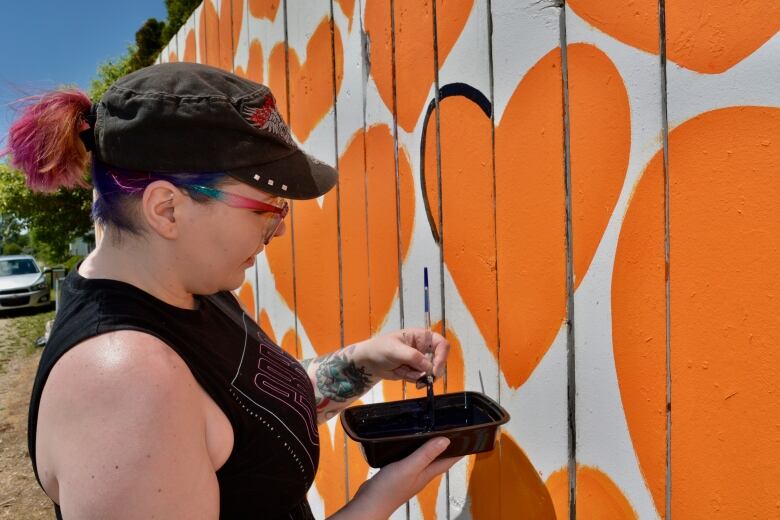Regina resident is painting educational mural honouring lost residential school children
215 orange hearts pepper the fence; additional art to be added

Regina is in the beginning days of what is suspected to be a long, drawn-out heat wave. But that is not stopping a Mtiswoman from standing out in the sun for hours a day painting a heartfelt tribute to those buried in unmarked graves at Canada's residential schools.
Desiree Terry is painting 215 orange hearts on a long, 2-metre tall white fence in the alleyway behind 6th Avenue North in Regina. The bright hearts can be spotted from adjacent Argyle Street.
The 215 hearts represent the children whose unmarked graves were recently part of a preliminary discovery at the former Kamloops Indian Residential School in British Columbia.
Terry, a masters of social work student, first knew she wanted to do something special after watching a Saskatchewan Association of Social Workerswebinar withCindy Blackstock, executive director of theFirst Nations Child and Family Caring Society of Canada.

Blackstockruns a project called 'Heart Garden.' Heart gardens can take many different forms, and are being created byresidents across the country in memory of children lost to the residential school system and to honour residential school survivors and their families.
"I had been thinking about what kind of project I could do to pay tribute to stolen children. And I wasn't sure until my partner and I drove by my parents' big, huge fence, and it had been tagged with graffiti. And shortly after, my parents got a notice that it had to be taken care of," Terry said.
The graffiti contained an obscenity.
"So what I thought was, 'this is a big, beautiful, blank canvas, that is a great opportunity to make a statement. And it's something that lots of people walk by.'"

Terry says the orange colour of the hearts alludes to Orange Shirt Day, so namedbecause of residential school survivorPhyllis Webstad, aNorthern Secwpemc from the Stswecem'c Xgat'tem First Nation in British Columbia. She had wanted to be able to wear her favourite orange shirt to residential school, butit was taken away.
"I felt that orange is a good colour to honour survivors and the children who didn't make it home," Terry said.
The decision to paint 215 orange hearts was made before the preliminary discovery of751 unmarked graves for Indigenous children and adults who died at the former Marieval Indian Residential School in Cowessess First Nation, Sask. The discovery was announced Thursday
"I still want to honour all of the children who haven't made it home and all of the survivors that are still dealing with the fallout of residential schools. Just because the graves are found doesn't mean that it's over," said Terry.
While the basic heart shapes have been painted, Terry is by no means close to finishing. To honour all those lost, she will be filling the hearts with numbers of unmarked graves found at different sites across the country,imagery that issignificant to First Nations and Mtis, Cree words and information about the treaty lands of Saskatchewan.
"I would love to have other Indigenous artists collaborate, if they want to, on getting some of these hearts filled in."

Terry said that the news of the unmarked graves has been hard on her.
"There's been so many people who have been talking about this for a long time. So part of me is just ... I feel relieved. But I also feel angry that it's taken so long for people to just listen to what's been said for a long time," Terry said.
"But I just I really hope that something like this can do those children justice, honouring them and honouring the people that are still here. And also educating the people that don't know. It's never too late to learn. And there's so much information out there that people can take the time to learn."
Supportis available for anyone affected by their experience at residential schools, and those who are triggered by these reports.
A national Indian Residential School Crisis Line has been set up to providesupportfor residential school survivorsand others affected. People can access emotional and crisis referral services by calling the 24-hour national crisis line: 1-866-925-4419.












_(720p).jpg)


 OFFICIAL HD MUSIC VIDEO.jpg)
.jpg)



























































































